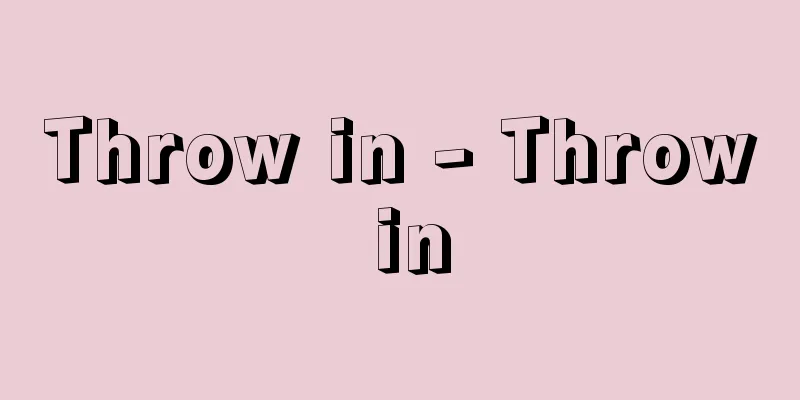Livestock farming - livestock farming

|
A form of agriculture that aims to increase the overall productivity of agricultural management by organically linking the crop sector, such as grain and vegetable crops, with the livestock sector and managing it appropriately. The benefits of incorporating livestock farming into crop farming (integrated agriculture) include the production of livestock products, the production of manure, and the utilization of animal power. In addition to using crop stems and leaves and vegetable waste as feed, incorporating feed crops as part of the rotation crops can help maintain the fertility of the soil. Livestock farming, as typified by crop rotation farming, is a farming method that developed in Western Europe, where the saying "without livestock there is no agriculture" was used. In Japan, where rice cultivation in paddy fields has been the norm, crop rotation has not been very well developed. However, during the rural depression of the early Showa period, livestock farming was encouraged as a way to save on purchased fertilizer by using manure, but interest in it was low in general due to restrictions imposed by the so-called parasitic landowner system. After the Second World War, the necessity of livestock farming gradually came to be recognized. However, after 1960 (Showa 35), in response to the high economic growth, agricultural modernization (i.e. mechanization) was rapidly promoted by agricultural government, mainly focusing on rice cultivation. As a result, the rural population rapidly decreased, the number of rice monoculture farmers and part-time farmers increased, and there was almost no development of livestock farming that combined rice cultivation and livestock farming. In 1967, rice production peaked at 14.45 million tons, but at the same time, a "surplus" occurred, leading to the adoption of a policy of reducing rice production. Because agricultural modernization policies promoted rice monoculture farming without livestock farming, this not only contradicted the rationality of family-run farms in Japan, but also led to a decline in soil fertility, which is the basis of agricultural productivity. Therefore, it was only natural that livestock farming, or diversified livestock management, was proposed in order to prevent a decline in soil fertility and link rice production reduction with crop rotation. Livestock farming (integrated livestock management) will likely become increasingly important in the future as it utilizes natural forces, that is, agriculture carried out within the natural ecosystem. [Tadashi Sato] [Reference items] | |Source: Shogakukan Encyclopedia Nipponica About Encyclopedia Nipponica Information | Legend |
|
農業の一形態。穀作、蔬菜(そさい)作などの耕種部門と養畜部門とを有機的に結び付け、その適切な運営によって農業経営全体の生産性を高めようとするものである。耕種農業に養畜を取り入れること(複合的農業)の効用として、畜産物の生産、厩肥(きゅうひ)の生産、畜力利用などがあげられる。また、作物の茎葉、野菜くずなどの飼料への利用のほか、飼料作物を輪作作物の一つとして組み込むことにより、土壌の地力維持を図ることができる。 有畜農業は、輪栽式農業に典型的にみられるように、「家畜なければ農業なし」といわれた西欧において発達した農法である。わが国においては、水田稲作を主としてきたため輪作があまり発達しなかった。しかし、昭和初期の農村不況のころ堆(たい)厩肥で購入肥料を節約するため有畜農業が奨励されたことがあるが、いわゆる寄生地主制による制約などもあって、一般に関心は低かった。 第二次世界大戦後、有畜農業の必要性がしだいに認識されるようになってきた。しかし、1960年(昭和35)以降、高度経済成長に対応して、農政によって稲作を中心に農業の近代化=機械化が急速に進められた。このため、農村人口は急速に減少するとともに、水稲単作農業と兼業農家が増大し、稲作と畜産の結び付いた有畜農業の発展はほとんどみられなかった。 1967年に米生産は1445万トンのピークに達したが、同時に「過剰」が発生し、減反政策がとられるようになった。農業近代化政策は畜産を欠いた稲単作農業を推進するため、わが国の家族的農業経営の合理性と矛盾するばかりでなく、農業生産力の基礎である地力の低下をもたらすことになる。 そこで、地力の低下を防ぎ、減反=転作と結び付けるためにも、有畜農業である有畜複合経営が提起されてきたのは当然である。 自然力の利用、すなわち自然生態系のなかで行われる農業にとって、有畜農業(有畜複合経営)は今後ますます重要となるであろう。 [佐藤 正] [参照項目] | |出典 小学館 日本大百科全書(ニッポニカ)日本大百科全書(ニッポニカ)について 情報 | 凡例 |
Recommend
Kikuka [town] - Kikuka
A former town in Kamo-gun, northern Kumamoto Prefe...
Kidd, W.
…British pirate. His real name was William Kidd. ...
School refusal - toukoukyouhi
When a child refuses to go to school for psycholog...
Spot trading - Genbutsu torihiki
Goods that are already in existence at the time o...
Germination - Hatsuga
It refers to the resumption of growth of the seed...
Malignant myopia - myopia
⇒Pathological myopia Source: About Shogakukan Digi...
Ah-yeon - Ah-yeon
...The capital of the province of the same name, ...
Library
Libraries. Libraries are the place where internati...
Football in the first year of the Man'en era
A full-length novel by Oe Kenzaburo. It was seria...
I am here
...The name of a place in Fuwa County, Mino Provi...
Red-eared dragon - Red-eared dragon
...Briar pipes are made from the roots of E. arbo...
Shonan [town] - Shonan
A former town in Higashikatsushika County, northwe...
Mr. Kano
There are several families, but the most famous ar...
barbarians
…However, this term was rarely applied to the Rom...
Song Yuan coins
Copper coins minted in the Song (960-1279) and Yua...









